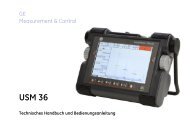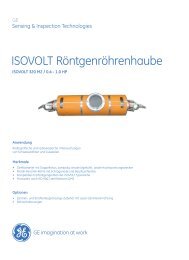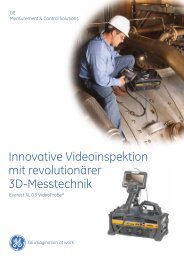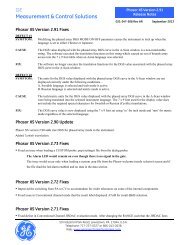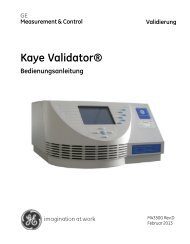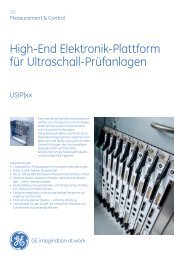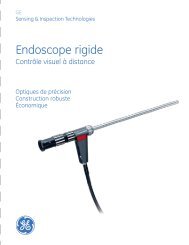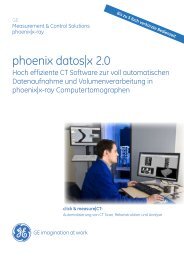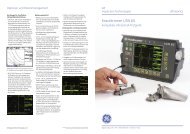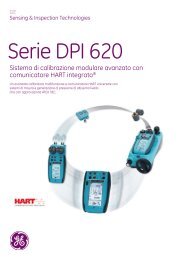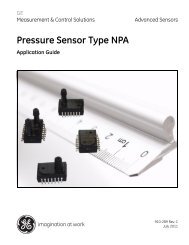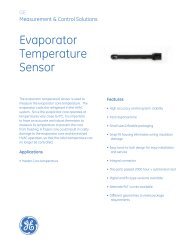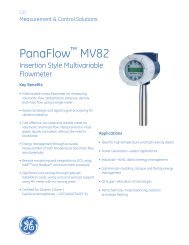Gas Turbine Vibration Monitoring - GE Measurement & Control
Gas Turbine Vibration Monitoring - GE Measurement & Control
Gas Turbine Vibration Monitoring - GE Measurement & Control
Create successful ePaper yourself
Turn your PDF publications into a flip-book with our unique Google optimized e-Paper software.
<strong>Gas</strong> <strong>Turbine</strong><br />
<strong>Vibration</strong> <strong>Monitoring</strong><br />
– An Overview<br />
Mel Maalouf<br />
Applications Engineer, Bently Nevada ® Products<br />
<strong>GE</strong> Energy<br />
mel.maalouf@ge.com<br />
48 ORBIT [Vol.25 No.1 2005]
Introduction<br />
For well over 30 years, the Bently Nevada ® product<br />
line has been used by gas turbine manufacturers<br />
and end-users to monitor these important<br />
machines. More than perhaps any other type of<br />
turbomachinery, gas turbines have undergone the<br />
most dramatic evolution in the past several<br />
decades, with increased firing temperatures, usage<br />
of advanced – even exotic – composite and alloyed<br />
materials; extremely sophisticated cooling mechanisms<br />
for components such as blades, nozzles, and<br />
transition pieces; innovative methods to reduce<br />
emissions; and significant increases in overall thermal<br />
efficiencies. Not surprisingly, these technological<br />
innovations have made gas turbines the prime<br />
mover of choice for many power generation and<br />
mechanical drive applications. Today, there is an<br />
extremely large installed base of these machines<br />
around the world.<br />
However, while gas turbines have unquestionably<br />
evolved in sophistication, the basic approach to<br />
vibration monitoring on these machines has<br />
remained largely unchanged. What has changed<br />
over the last several years is the additional measurements<br />
available today that complement Bently<br />
Nevada vibration monitoring products, such as<br />
combustion instability monitoring, hazardous gas<br />
detection, flame detection, exhaust gas temperature<br />
diagnostics, thermodynamic performance<br />
monitoring, and overspeed detection.<br />
This article reviews the basics of monitoring vibration<br />
on gas turbines, providing recommendations,<br />
and discussing some of the new measurements now<br />
available. It begins with a review of the two broad<br />
classifications of gas turbines: aeroderivative and<br />
industrial.<br />
[Vol.25 No.1 2005] ORBIT 49
A P P L I C A T I O N S<br />
Aeroderivative <strong>Gas</strong> <strong>Turbine</strong>s<br />
Aeroderivative gas turbines (sometimes called aeroderivative<br />
engines – the terms are used interchangeably in<br />
this article) are derived from aircraft applications. To<br />
meet the needs of the aerospace industry, aeroderivative<br />
gas turbines have primary emphasis on power-tosize/weight<br />
ratios, since smaller, lighter engines reduce<br />
the weight of the aircraft, and therefore fuel consumption.<br />
With few exceptions, aeroderivatives use rolling<br />
element, rather than fluid-film, bearings. Some also<br />
employ concentric shafts, allowing the various compressor<br />
and turbine stages to run at different speeds,<br />
and making them better able to produce the large pressure<br />
ratios required in certain engine designs.<br />
Obviously, the primary function of a gas turbine when<br />
used on jet aircraft is to generate the thrust necessary<br />
for propulsion. This is accomplished by channeling the<br />
hot gases through a nozzle and, sometimes, by also turning<br />
the large fan in the engine (turbo-fan or high-bypass<br />
engine). When adapted for industrial applications,<br />
however, the thrust must be converted into mechanical<br />
torque, able to drive a generator, process compressor,<br />
blower, pump, propeller (when used in marine propulsion),<br />
or other driven machine.<br />
<strong>Gas</strong> <strong>Turbine</strong><br />
<strong>Gas</strong> Generator<br />
Compressor <strong>Turbine</strong><br />
50 ORBIT [Vol.25 No.1 2005]<br />
Power<br />
(or Reaction)<br />
<strong>Turbine</strong><br />
FIG. 1 | NOMENCLATURE USED FOR MANY AERODERIVATIVE GAS TURBINES<br />
Channeling the hot gases into an aerodynamically<br />
coupled power turbine, rather than a nozzle, accomplishes<br />
this. The hot gases spin the power turbine which<br />
is coupled mechanically to the driven equipment.<br />
The nomenclature used when referring to aeroderivative<br />
gas turbines is shown in the simplified diagram of<br />
Figure 1. It illustrates that most aeroderivative gas turbines<br />
consist of two fundamental components – the gas<br />
generator and the power (sometimes called ‘reaction’)<br />
turbine. Collectively, these are referred to as the “gas<br />
turbine.” While the gas generator does have an integral<br />
turbine section, it serves only to extract enough energy<br />
to drive the compressor section of the engine. The rest<br />
of the energy produced by the gas generator is in the<br />
form of hot, high-pressure, high-velocity gas, which<br />
drives the power turbine. As shown in Figure 1, the<br />
power turbine is not mechanically coupled to the gas<br />
generator – there is no shaft linking the two components.*<br />
They run at different rotational speeds and are<br />
coupled aerodynamically by the hot gas produced in<br />
the gas generator.<br />
*While this is true for most aeroderivatives, there are some<br />
exceptions. For example, the <strong>GE</strong> LM6000 has a power turbine<br />
that is an integral, direct-coupled part of the engine rather than<br />
a separate aerodynamically coupled element.<br />
Driven Machine<br />
(pump, generator, etc.)
Industrial <strong>Gas</strong> <strong>Turbine</strong>s<br />
Unlike aeroderivative gas turbines, industrial gas turbines<br />
are not derived from a design with a different<br />
primary purpose. Instead, they are intended only for<br />
industrial applications, and they employ design features<br />
that reflect industrial needs, rather than the needs of<br />
aircraft. They use fluid-film bearings for both radial<br />
and axial shaft support. They generally employ conventional<br />
lube oil and seal oil auxiliary systems, and they<br />
feature heavier construction, since the intense weightdriven<br />
concerns that govern aeroderivative designs are<br />
not present. And, unlike the concept of a gas generator<br />
section and a separate reaction turbine present in most<br />
aeroderivatives, many industrial gas turbines have a<br />
direct-coupled, integral power turbine that extracts all<br />
the energy needed to both drive the compressor section<br />
of the turbine and transmit torque to the driven equipment<br />
through an output shaft.<br />
While these are obviously not the only differences<br />
between industrials and aeroderivatives, they do highlight<br />
some of the fundamental differences. As will<br />
be shown, the approaches to vibration monitoring<br />
used for these machines stem largely from the type of<br />
bearings employed, causing distinctly different systems<br />
to be used for aeroderivatives than for industrials in<br />
most cases.<br />
Variations<br />
Categorizing gas turbines into one of two families,<br />
aeroderivative or industrial, does not fully reflect some<br />
of the nuances of design within the industrial family.<br />
Clearly, referring to a particular gas turbine as an<br />
“aeroderivative” is quite straightforward – it was either<br />
originally intended for use on aircraft (and has simply<br />
been adapted for industrial applications), or it was not.<br />
However, it is also typical for industrial gas turbines to<br />
be further subcategorized into “packaged” and “heavy”<br />
classifications, and we will use this nomenclature when<br />
a distinction is necessary in this article.<br />
By “packaged” industrial gas turbines, this article is<br />
referring to those with power outputs generally less than<br />
about 20MW which are available as a completely packaged<br />
system on a single, movable skid – the gas turbine,<br />
auxiliaries, driven machine (often generator, compressor,<br />
or pump), and sometimes even the controls.<br />
Although not derived from an aircraft design, this<br />
A P P L I C A T I O N S<br />
allows packaged industrials to enjoy one of the main<br />
advantages of aeroderivatives – namely, the ability to<br />
rapidly “swap out” the entire gas turbine when major<br />
maintenance is required. In contrast, larger gas turbines<br />
(sometimes called “heavy” or “heavy-duty”) are not<br />
packaged in this single-skid fashion. Consequently, it is<br />
more common to see maintenance performed in-situ<br />
on these units, or with individual components or engine<br />
sections sent to a repair facility. The “engine swap”<br />
method is not generally a viable option for these<br />
machines.<br />
Hybrids<br />
It is also worth mentioning several new gas turbines<br />
that have emerged over the last few years, blending<br />
design features that were traditionally the exclusive<br />
domain of either aeroderivatives or industrials, but not<br />
both. Although these ‘hybrid’ designs incorporate<br />
selected elements of both categories to a greater or lesser<br />
extent, they tend to align as either industrials or<br />
aeroderivatives in terms of the way they are monitored,<br />
generally a function of the types of bearings used.<br />
Maintenance<br />
Because aeroderivative gas turbines derive from engines<br />
originally designed for aircraft, it is useful to consider<br />
the difference in maintenance practices that have historically<br />
been employed in the aerospace industry, compared<br />
with the practices used in the power generation<br />
and hydrocarbon processing industries where industrial<br />
gas turbines are primarily focused.<br />
Since aerospace applications of gas turbines, whether<br />
military or civilian, involve transportation of human<br />
beings, both as passengers and as pilots, safety is of paramount<br />
concern. An engine failure in an aircraft has a<br />
much higher likelihood of jeopardizing human life than<br />
a gas turbine failure in most industrial settings. Not surprisingly,<br />
aerospace maintenance practices are primarily<br />
driven by safety concerns. Failures simply cannot<br />
be tolerated because they impact much more than just<br />
business interruption. Governing agencies mandate<br />
that engines be maintained and inspected at specified<br />
running-hour intervals.<br />
In addition, an aircraft is not in the sky 100% of<br />
the time, running continuously. Thus, the ability<br />
to perform inspections and maintenance during these<br />
[Vol.25 No.1 2005] ORBIT 51
A P P L I C A T I O N S<br />
relatively frequent windows of “down time” is more<br />
practical than with industrial machines, which generally<br />
run continuously. Consequently, gas turbine maintenance<br />
in the aerospace industry employs the practice<br />
of “swapping out” an engine or major sub-assemblies<br />
in need of inspection and repair with a fresh engine or<br />
sub-assembly, much as one might take a faulty starter<br />
out of an automobile, replace it with a refurbished unit,<br />
and send the old starter in for repair and refurbishment.<br />
The aerospace industry has become quite proficient at<br />
rapid change-out of parts and even entire engines. This<br />
practice allows aircraft to remain in service as much as<br />
possible, but without jeopardizing safety.<br />
In contrast, industrial gas turbines are often involved<br />
in continuous service that does not have frequent<br />
“normal” machine downtime of sufficient duration to<br />
perform maintenance and inspections. Instead, maintenance<br />
outages must be scheduled, often only once per<br />
year or even less frequently. While industrial gas turbines<br />
rely in part upon set intervals for determining<br />
when maintenance is required, such as a fixed number<br />
of operating hours for a set of blades, they also rely heavily<br />
upon continuous condition-based information for<br />
determining maintenance. Industrial gas turbines (with<br />
notable exception of some packaged units as mentioned<br />
earlier) are generally not removed from service and<br />
replaced with a refurbished unit, as is often the case for<br />
aeroderivatives. This is partly due to the historical maintenance<br />
practices in the process industries versus the<br />
aerospace industry, but it is also due to the design of<br />
the machines themselves. Heavy industrial gas turbines<br />
are simply not designed to be lifted out of place as a single<br />
unit and replaced with a new unit. In contrast,<br />
aeroderivatives (and some packaged industrials) are<br />
almost always designed to facilitate such a “drop in”<br />
replacement approach.<br />
The aerospace heritage of aeroderivatives helps explain<br />
why the industrial usage of aircraft-derived gas turbines<br />
has resulted in maintenance practices and contractual<br />
scenarios that are often closer to those of the aerospace<br />
sector than the industrial sector. Many aeroderivative<br />
users will even contract with an Original Equipment<br />
Manufacturer (OEM) to have entire spare engines onhand,<br />
or will purchase spare engines and keep them in<br />
their own warehouse for rapid change-outs should a failure<br />
occur. In some instances, a crew can change out an<br />
entire engine in as little as eight hours.<br />
52 ORBIT [Vol.25 No.1 2005]<br />
Before turning to a discussion of condition monitoring<br />
differences between these two types of gas turbines, it is<br />
important to note that differences in maintenance<br />
philosophies should not be construed as being inferior<br />
or superior to one another, or that the aerospace industry<br />
is “safe” while others are not. Aircraft engines simply<br />
function under very different operating and business conditions<br />
than do gas turbines in an industrial setting. The<br />
maintenance practices and philosophies that have evolved<br />
to address these machines reflect those differences.<br />
Condition <strong>Monitoring</strong> and Machinery Protection<br />
Understanding the background behind the two basic<br />
categories of gas turbines – aeroderivative and industrial<br />
– is helpful because it provides a framework for<br />
better understanding why two approaches to condition<br />
monitoring for gas turbines have arisen over the years.<br />
Basically, aeroderivatives use one approach while industrials<br />
use a different approach, as discussed next.<br />
GAS TURBINE MAINTENANCE IN<br />
THE AEROSPACE INDUSTRY EMPLOYS<br />
THE PRACTICE OF “SWAPPING<br />
OUT” AN ENGINE OR MAJOR SUB-<br />
ASSEMBLIES.
Industrial <strong>Gas</strong> <strong>Turbine</strong>s<br />
<strong>Vibration</strong> monitoring for industrial gas turbines<br />
is much the same as most other types of high-speed<br />
turbomachinery that employ fluid-film bearings. This<br />
is summarized in Table 1. Similar recommendations<br />
occur in widely used industry standards pertaining to<br />
gas turbines .<br />
TABLE 1 | RECOMMENDED VIBRATION MONITORING FOR INDUSTRIAL GAS TURBINES<br />
M EASUREMENT D ESCRIPTION<br />
Radial Bearings<br />
Thrust Bearings<br />
Shaft Speed /<br />
Phase Reference<br />
Casing <strong>Vibration</strong> 2,3<br />
Eccentricity<br />
N OTES:<br />
R ECOMMENDED FOR ALL DESIGNS<br />
A P P L I C A T I O N S<br />
Almost every manufacturer of industrial gas turbines<br />
will provide provisions (i.e., holes drilled and tapped)<br />
for the radial vibration, axial position, and Keyphasor ®<br />
probes noted in the first three entries of Table 1. Often,<br />
these transducers are used as part of acceptance testing<br />
and commissioning. For the oil and gas industries, this<br />
requirement is typically driven by American Petroleum<br />
Two proximity probes should be mounted in an X-Y (i.e., orthogonal) configuration at or near each bearing, directly<br />
observing the relative motion between bearing and shaft. Recommended as a shutdown parameter.<br />
Two proximity probes should be used, observing the axial position of the shaft within the thrust bearing clearance, and<br />
voting 1 these two probes. Recommended as a shutdown parameter.<br />
A Keyphasor ® transducer should be supplied on each independent (non-mechanically coupled) shaft to provide a once-perturn<br />
reference signal for determining vibration phase and shaft rotative speed. It is generally recommended that the<br />
Keyphasor transducer be installed on the driver in a machine train, so that if the unit is run uncoupled, a phase reference<br />
signal will still be available. This is not possible when a Keyphasor transducer is only installed on the driven machine.<br />
S UPPLEMENTAL MEASUREMENTS RECOMMENDED FOR SELECTED LAR<strong>GE</strong>- FRAME MACHINES<br />
For machines that are extremely compliant (i.e., exhibit significant motion between the bearing housing and free space),<br />
seismic vibration transducers should be mounted on the machine’s casing (typically, the radial bearing housings), and<br />
these signals should be used along with the radial bearing proximity probes for assessing machinery malfunctions and for<br />
use as shutdown protection when vibration becomes excessive. If a gas turbine does not exhibit significant compliance in<br />
its casing or mounting structures, these measurements may be considered optional, as the radial proximity probes will<br />
generally provide superior machinery protection and diagnostic capabilities.<br />
Gravity sag causing extremely massive rotors to bow from their own weight after sitting idle for an extended period of<br />
time is a well-known phenomenon on large steam turbines. This can also affect many of today’s largest gas turbines.<br />
Allowing a machine to reach speed when too much bow is present can cause extensive damage and a direct or indirect<br />
measurement of shaft bow is often used as a control system permissive, ensuring the machine is not started when<br />
residual bow is outside of permissible limits. An eccentricity monitor is designed to measure this residual shaft bow during<br />
the slow speeds encountered as part of start-up and while on turning gear. It is measured using a single radial proximity<br />
probe. On gas turbines, the most accessible location for this measurement will often be near a coupling, several shaft<br />
diameters away from the nearest bearing. This ensures the probes are not located too near a nodal point.<br />
1. A discussion of voting logic and philosophies is beyond the scope of this article, but suffice to say that a thrust bearing failure, unlike high vibration<br />
at a radial bearing, can actually cause a probe to go beyond its linear range and can be indistinguishable from an instrument failure under some<br />
circumstances. To assist in preventing false shutdowns, two probes are used in redundant fashion and the signals are voted. Only when both probes<br />
show excessive axial movement is a high thrust excursion annunciated. For additional information, refer to the article “Voting Thrust <strong>Measurement</strong>s<br />
with Other Parameters” in the First Quarter 2001 issue of ORBIT, pp. 51-54.<br />
2. For additional information on this measurement, refer to the article “<strong>Vibration</strong> Characteristics of Industrial <strong>Gas</strong> <strong>Turbine</strong>s” in the Third Quarter 2000<br />
issue of ORBIT, pp. 18-21.<br />
3. Occasionally, some manufacturers will include only seismic transducers on smaller industrial gas turbines. While these afford a degree of machinery<br />
protection capabilities, proximity probes will generally also be available from the OEM as a standard option. We recommend the installation of<br />
these additional proximity transducers because they allow superior machinery diagnostic information – particularly important when the machine<br />
will be in unstaffed or inaccessible locations such as offshore platforms. They also allow a greater degree of machinery protection because they are<br />
sensitive to machinery problems that originate at the rotor (such as bearing preloads, bearing wear, and other conditions) that may not transmit<br />
faithfully to the machine’s casing and/or be observable with casing-mounted seismic transducers.<br />
[Vol.25 No.1 2005] ORBIT 53
A P P L I C A T I O N S<br />
API 616 is one of the most<br />
widely used standards for<br />
industrial gas turbines.<br />
It references API 670<br />
for vibration<br />
monitoring.<br />
Institute (API) Standard 616, covering industrial gas turbines,<br />
and calls for not only the use of proximity probes<br />
during acceptance testing of the machine, but also their<br />
inclusion as part of a permanent machinery protection<br />
(monitoring) system. The details of this permanent<br />
monitoring system are covered in a separate standard,<br />
API 670. It is common for end users to use this standard<br />
in industries beyond just petroleum, such as power generation.<br />
Thus, gas turbines used across many different<br />
industries will often be supplied with transducers and<br />
monitoring systems in accordance with API 670.<br />
Regardless of whether API 670 is specified or not, in<br />
many cases the manufacturer’s standard offering for<br />
machinery protection will include a Bently Nevada<br />
monitoring system, such as 3500, 3300, or 1701, connected<br />
to the transducers noted in Table 1 and interconnected<br />
to the turbine control system for alarming<br />
and auto-shutdown. In other cases, the manufacturer<br />
will leave the transducers on the machine, but they will<br />
not be connected to a permanent monitoring system<br />
unless specified by the end-user, in which case the manufacturer<br />
generally provides a standard option for a<br />
Bently Nevada monitoring system. In still other cases,<br />
the manufacturer will not provide either the transducers<br />
or the monitoring system, unless the customer specifies<br />
otherwise. However, holes will generally be drilled<br />
54 ORBIT [Vol.25 No.1 2005]<br />
and tapped to allow for the installation of transducers<br />
for connection to a monitoring system at<br />
a later time. It is strongly recommended that end<br />
users ensure that all machines they purchase are<br />
at least supplied with provisions for proximity<br />
probes, as this is generally far less expensive and<br />
invasive than a project to drill and tap holes in a<br />
machine in the field as part of a later transducer<br />
retrofit.<br />
It is important to note that considerable engineering<br />
often must be applied to accommodate vibration<br />
transducers, particularly when they are<br />
embedded in the machine, as is frequently the case<br />
with proximity probes. <strong>Gas</strong> turbines can present<br />
special challenges, such as routing cables through<br />
areas with high temperatures and/or areas in direct<br />
contact with lubricating oil. Machinery OEMs have<br />
often worked collaboratively with us to develop special<br />
solutions to such issues. For example, one wellknown<br />
manufacturer routes the cables for certain<br />
bearings on its industrial gas turbines through oil<br />
return lines, ensuring that the cables remain well<br />
below their upper temperature ratings, but presenting<br />
special challenges for sealing against oil leakage.<br />
Bently Nevada high-pressure feed-through cable<br />
assemblies are available in special lengths to prevent<br />
pressurized oil migration on the outside of the cable,<br />
as well as the incorporation of FluidLoc ® technology<br />
in many of our newest transducer cables that prevents<br />
oil migration through the inside of the cable. Other<br />
manufacturers have worked with us to develop special<br />
probe configurations, unique to their machines, that<br />
address tight or difficult-to-access mounting locations.<br />
Obviously, we advocate not just installation of the<br />
transducers noted in Table 1, but also their connection<br />
to a permanent monitoring system. And, the vast majority<br />
of gas turbine manufacturers go beyond just making<br />
‘provisions for’ these transducers and instead provide<br />
both permanently installed transducers and monitoring<br />
systems as standard. They, and their customers,<br />
understand the valuable role a monitoring system provides<br />
in protecting the gas turbine and in helping to<br />
diagnose problems that may arise during the machine’s<br />
service. Indeed, the emergence of long-term service contracts<br />
have helped OEMs partner more closely with<br />
their customers, allowing the OEM to play a more
active role in operating and maintenance decisions over<br />
the life of the machine. This has led to more prevalent<br />
utilization of not just transducers and permanent<br />
monitoring systems, but also the diagnostic and condition<br />
monitoring software connected to such systems,<br />
allowing end users and OEMs alike to more easily incorporate<br />
detailed condition information into their asset<br />
management decisions.<br />
These are just a few examples, intended to underscore<br />
the importance of working with the OEM when specifying<br />
vibration monitoring for new or retrofit applications.<br />
We are very proud of the working relationships<br />
that have been established with virtually every gas<br />
turbine manufacturer worldwide. These relationships<br />
allow us to supply pre-engineered monitoring solutions<br />
that have been approved by the OEM for use on their<br />
machines, and which reflect both the needs of the OEM<br />
and the end user. Because of the familiarity they have<br />
with our quality solutions, you can confidently work<br />
with your machinery OEM and ask for Bently Nevada<br />
products and services by name.<br />
Aeroderivative <strong>Gas</strong> <strong>Turbine</strong>s<br />
As has already been discussed, aeroderivative engines<br />
differ from their industrial counterparts in at least<br />
three very important respects pertaining to condition<br />
monitoring:<br />
r They were originally designed for use as aircraft<br />
propulsion, and are usually adapted for industrial<br />
applications by the use of an aerodynamically coupled<br />
power turbine which converts engine thrust into<br />
mechanical torque;<br />
r They use rolling element, rather than fluid-film,<br />
bearings (with exception of the aerodynamically<br />
coupled power turbine section, which sometimes<br />
uses fluid-film bearings);<br />
r The maintenance practices surrounding aeroderivatives<br />
rely predominantly on changing the engine<br />
out in its entirety, rather than performing in-situ<br />
repairs.<br />
Next, the implications of each of these differences are<br />
examined.<br />
A P P L I C A T I O N S<br />
GAS TURBINES USED ACROSS MANY DIFFERENT INDUSTRIES WILL OFTEN BE SUPPLIED<br />
WITH TRANSDUCERS AND MONITORING SYSTEMS IN ACCORDANCE WITH API 670.<br />
Aircraft Heritage<br />
An aircraft engine does not run continuously. While<br />
it must be extremely dependable in flight, once the<br />
aircraft is on the ground a failure may be inconvenient<br />
– and perhaps expensive – but it is not life threatening.<br />
Conversely, when the engine is running during a flight,<br />
one is not likely to stop it unless it sustains truly<br />
catastrophic damage (such as foreign object damage),<br />
which keeps it from operating. Although modern<br />
commercial aircraft are designed to be able to operate<br />
safely even with the loss of one engine, an engine is not<br />
turned off in-flight unless warranted by the most<br />
extreme circumstances.<br />
With this in mind, it is easy to understand that as aircraft<br />
engines evolved and vibration monitoring was<br />
introduced, the purpose of vibration monitoring was<br />
not so much to provide detailed mechanical diagnostics<br />
as it was to provide very basic protective functions<br />
for failures that might be encountered during a flight –<br />
namely, foreign object damage as mentioned above.<br />
Such damage tends to result in loss of blades and gross<br />
imbalance, which generally can be detected by examining<br />
the vibration amplitude of frequencies primarily<br />
centered about the running speed (1X) of the engine.<br />
Consequently, the vibration monitoring for in-flight<br />
engines is generally designed to filter out everything<br />
except the basic shaft rotational speeds. On some<br />
engines, this is accomplished by processing the vibration<br />
signal through a narrow band-pass filter that attenuates<br />
everything except a very narrow band of<br />
frequencies centered about the running speed of the<br />
engine. The center frequency of the filter automatically<br />
“tracks” up and down as the engine changes speed by<br />
use of a speed signal from the engine shaft. On other<br />
engines, the filter does not track; it simply uses a broad<br />
enough pass-band to encompass the 1X vibration component<br />
for the envisioned range of running speeds.<br />
Also, many aeroderivatives use concentric shafts which<br />
permit compressor and turbine sections to operate at<br />
different speeds, so there are often multiple shaft speeds<br />
that must be monitored.<br />
Regardless of whether a tracking filter or fixed-band filter<br />
is used, by looking at only the 1X aspects of the<br />
vibration signal, the pilot is alerted to catastrophic<br />
[Vol.25 No.1 2005] ORBIT 55
A P P L I C A T I O N S<br />
engine damage, but certainly not subtle changes in<br />
the turbine such as bearing wear. This is by design.<br />
There is no point concerning a pilot with such information<br />
when what is needed is merely a go/no-go<br />
type of signal that indicates whether the engine has<br />
sustained damage that is too serious to allow continued<br />
operation.<br />
As aircraft engines began to be adapted for industrial<br />
applications, this approach to monitoring that had<br />
evolved for use on “flying” engines remained largely<br />
unchanged. Hence, the monitoring systems on most<br />
aeroderivatives today suppress most aspects of the vibration<br />
signal with the exception of 1X by using band-pass<br />
filtering as described above. While monitoring these<br />
frequencies is useful for detecting gross problems such<br />
as loss of blades and severe imbalance, it is not really<br />
capable of permitting advanced condition monitoring<br />
to the extent possible on industrial gas turbines. This is<br />
partly due to the signal processing performed on the<br />
raw vibration signal, which suppresses many frequency<br />
components as just explained. However, it is also due<br />
to the types of transducers and mounting locations,<br />
as discussed next.<br />
A WORD ABOUT POWER TURBINES…<br />
56 ORBIT [Vol.25 No.1 2005]<br />
Rolling Element Bearings<br />
Because aeroderivative engines use rolling element<br />
bearings, bearing vibration cannot be addressed with<br />
conventional proximity probes – the rotor is essentially<br />
rigidly fixed to the bearing providing no relative<br />
vibratory movement between bearing and shaft. Thus,<br />
mounting a conventional proximity probe to observe<br />
the shaft vibration relative to the bearing (as is done<br />
with industrial gas turbines) is not an option. One<br />
approach that we pioneered is to install special highgain<br />
proximity probes in aeroderivatives that observe<br />
the outer ring of the bearing. As the elements of the<br />
bearing pass over a fixed location on the outer ring, tiny<br />
deflections occur. These deflections are observable by<br />
the probe and provide both rotor-related and bearingrelated<br />
information; however, this practice is not yet<br />
widespread.<br />
[Editor’s Note: For additional information on this monitoring<br />
method, refer to the article “Aeroderivative Internal Transducer<br />
Design” in the Second Quarter 2001 issue of ORBIT]<br />
Aeroderivative gas turbines, as previously discussed, often incorporate an aerodynamically<br />
coupled power turbine, which in turn drives a load such as a generator or pipeline compressor.<br />
Often, the power turbine, since it is used only in industrial applications, will use<br />
fluid-film bearings rather than the rolling element bearings typical of aeroderivative gas<br />
generators. In this case, it is recommended that the power turbine be monitored with conventional<br />
radial proximity probes in the familiar X-Y configuration. In other cases, the power<br />
turbine uses rolling element bearings, in which case it is monitored with casing-mounted<br />
transducers, just as the gas generator portion of the machine. Internally mounted bearing<br />
housing accelerometers, as discussed above, are also a viable option for these designs.<br />
Bently Nevada does not recommend the exclusive reliance upon casing-mounted seismic<br />
transducers for power turbines that employ fluid-film bearings. Fluid-film bearings serve<br />
to dampen rotor-related vibrations and simply do not allow sufficient transmission of these<br />
vibrations to the machine casing in many instances.
Another approach that is gaining interest among users<br />
is to mount accelerometers on the bearing housings,<br />
inside the machine. This approach does not require significant<br />
modifications to the bearing support structure<br />
and puts the transducer much closer to the source of<br />
vibration. Unlike fluid-film bearings, a rolling element<br />
bearing very stiffly couples shaft and bearing vibration<br />
to the bearing support structure. Thus, seismic transducers<br />
can be a good choice for these machines, provided<br />
they are mounted in a location to which shaft,<br />
bearing, and other vibration is faithfully transmitted.<br />
Because the transducers are “closer to the action” when<br />
mounted internally in this fashion, they are better able<br />
to observe bearing degradation and rotor-related problems<br />
(such as imbalance and misalignment) than transducers<br />
mounted on the outside of the engine. Also,<br />
the temperatures near the bearings – although inside<br />
the machine – are, ironically, less extreme than when<br />
transducers are mounted on the outside of the machine.<br />
OEMs and end users are encouraged to contact us if<br />
they would like to participate in this approach. This<br />
technique is presently being tested at several locations<br />
and has received support during dialogs with customers<br />
at several industry conferences.<br />
While internally mounted transducers show potential<br />
for providing superior machinery condition information<br />
and machinery protection capabilities, most<br />
aeroderivatives are not currently monitored with internal<br />
vibration transducers. Instead, these machines have<br />
historically been monitored by mounting casing<br />
accelerometers on the outside of the engine. The transducer<br />
mounting locations are generally chosen by the<br />
OEM to coincide with engine frame points that represent<br />
the most direct bearing-to-structure load path that<br />
is externally accessible.<br />
The signal processing applied to these transducers generally<br />
incorporates band-pass filtering, designed to capture<br />
little more than the 1X amplitude. In addition to<br />
the reasons already noted for such filtering, another<br />
practical reason is to ensure that the large amplitudes<br />
in the acceleration signals do not “swamp” the smaller<br />
rotor-related signals that are present. Most often, these<br />
high-frequency, high-amplitude signals are generated<br />
by blade/nozzle pass, by acoustic airflow through the<br />
gas generator and power turbine sections, and by combustor<br />
noise. Although the amplitudes can be high, the<br />
A P P L I C A T I O N S<br />
actual energy and destructive capabilities may be small.<br />
Even though acceleration units are the intrinsic output<br />
of an accelerometer, most aeroderivatives do not use<br />
acceleration units for monitoring. Instead, it is customary<br />
to integrate or double-integrate the signal, in addition<br />
to the band-pass filtering mentioned above,<br />
resulting in either velocity units (integrated acceleration)<br />
or displacement units (double-integrated acceleration).<br />
Although some OEMs recommend that both<br />
velocity and displacement units be used as part of a<br />
“dual path” monitoring scheme with alarm levels established<br />
for both, it is more typical to see machines that<br />
use velocity or displacement units, rather than both.<br />
Depending on aeroderivative engine size, make, and<br />
model, anywhere from one to three casing-mounted<br />
seismic transducers are typically supplied on the gas<br />
generator. As examples of this variation in the number<br />
of sensors and the signal conditioning applied to each,<br />
one popular two-spool machine (concentric shafts) uses<br />
two casing accelerometers, with tracking filters, to provide<br />
the 1X amplitude at both shaft speeds. Another<br />
manufacturer supplies one of its larger engines with<br />
three accelerometers with a fixed band-pass filter in each<br />
accelerometer circuit. The filters pass frequencies<br />
between 40 Hz and 350 Hz to the vibration monitor.<br />
Still another popular engine has historically been<br />
supplied with a single seismic transducer and a filter<br />
that suppresses all frequencies below 110 Hz. Thus,<br />
although the general approach is to use casing-mounted<br />
transducers exclusively and some form of signal conditioning<br />
that intentionally limits the frequency content<br />
seen by the monitoring system to a rather narrow band,<br />
there are very few other generalizations that can be made<br />
regarding the monitoring systems used on aeroderivative<br />
engines. The sensor scale factor, the sensor mounting<br />
footprint, the sensor mounting locations, the filter<br />
roll-offs and band-pass ranges, integration or doubleintegration<br />
– all tend to differ from one manufacturer<br />
and one engine to the next, and are normally detailed<br />
in a monitoring specification generated by the OEM.<br />
Bently Nevada monitoring systems are available to<br />
address these OEM specifications.<br />
Another aspect of monitoring aeroderivatives relates<br />
to the frequent requirement for a setpoint multiplier<br />
(often called “trip multiply”) capability in the monitoring<br />
system. This is a feature of the monitoring system<br />
[Vol.25 No.1 2005] ORBIT 57
A P P L I C A T I O N S<br />
whereby the alarm setpoints are temporarily elevated<br />
during start-up to allow the machine to pass through<br />
its first, and sometimes second, balance resonance(s)<br />
without generating spurious vibration alarms. Because<br />
aeroderivatives employ rolling element bearings, they<br />
exhibit considerably less damping than machines using<br />
fluid-film bearings or squeeze-film dampers. This<br />
results in higher synchronous amplification factors (i.e.,<br />
the ratio of vibration amplitude as the machine passes<br />
through a resonance to the vibration amplitude when<br />
operating well away from a resonance is quite large).<br />
Although the use of setpoint multiplier functionality<br />
is not strictly limited to aeroderivative turbines, its use<br />
is more predominant on these machines due to the<br />
rotordynamic response characteristics just discussed.<br />
Also, some OEMs use an inhibit function that bypasses<br />
alarms altogether, rather than setpoint multiplication.<br />
However, when feasible, it is advisable to use setpoint<br />
multiplication rather than complete bypass, as this<br />
ensures that the machine will always have some type of<br />
vibration alarms enabled, regardless of its operating<br />
state.<br />
58 ORBIT [Vol.25 No.1 2005]<br />
Aeroderivative Maintenance Practices<br />
The third difference between aeroderivatives and industrial<br />
gas turbines with respect to how they are monitored<br />
lies in the way that they are maintained. As has<br />
already been discussed, aeroderivatives rely more on<br />
maintenance practices that simply “swap out” an<br />
engine, rather than attempt in-situ repairs. The tendency<br />
for industrial units to incorporate more comprehensive<br />
condition monitoring is due, in part, to the<br />
inability to easily swap out the gas turbine. While this<br />
is feasible on aeroderivatives, and many industrial<br />
“packaged” units, it is not possible on so-called heavy<br />
industrial units. Hence, the need to diagnose the<br />
machine in-situ drives a greater reliance on condition<br />
monitoring achievable from vibration data. This is not<br />
to say that aeroderivatives and packaged industrials cannot<br />
benefit from more capable condition monitoring.<br />
It is merely to point out that the time to swap out an<br />
engine is often measured in hours, rather than days,<br />
and the relative speed with which an engine can simply<br />
be replaced when there are problems allow aeroderivative<br />
(and some packaged industrial) users the luxury of<br />
maintenance options that are not practical for heavy<br />
industrial units.<br />
ANOTHER ASPECT OF MONITORING<br />
AERODERIVATIVES RELATES TO THE<br />
FREQUENT REQUIREMENT FOR A<br />
SETPOINT MULTIPLIER (OFTEN CALLED “TRIP<br />
MULTIPLY”) CAPABILITY IN THE<br />
MONITORING SYSTEM.<br />
THE SETPOINT MULTIPLIER FUNCTIONALITY OF<br />
A MONITORING SYSTEM, AND THE REASONS<br />
FOR ITS USE, ARE DISCUSSED IN MUCH<br />
GREATER DETAIL IN API 670, APPENDIX I.
Recommendations for<br />
<strong>Vibration</strong> <strong>Monitoring</strong> on Aeroderivatives<br />
The vibration monitoring supplied with most aeroderivative<br />
packages is designed to provide a measure of<br />
basic machinery protection, but does not generally<br />
deliver the same level of diagnostic information for indepth<br />
condition assessment that can be achieved on<br />
industrial gas turbines fitted with proximity probes.<br />
This is not to say that condition monitoring on<br />
aeroderivatives is impossible, or does not provide value.<br />
It is merely to point out that aeroderivatives, compared<br />
with their industrial counterparts, present a different<br />
and more challenging set of constraints to the diagnostician.<br />
There are several things that can be done to<br />
improve the condition monitoring capabilities on<br />
aeroderivatives. The first, and often the simplest, is to<br />
bring not only the band-pass filtered vibration signal<br />
into the monitoring system (which is used for machinery<br />
protection purposes), but to also bring the unfiltered<br />
acceleration or velocity signal into the monitoring<br />
system. By doing this, the “raw” signal can be used by<br />
condition monitoring software to look at the full<br />
frequency content, providing additional useful signal<br />
content rather than merely the 1X amplitude which is<br />
generally all that is available within the band-pass<br />
filtered signal. Although the broadband acceleration<br />
signals are often difficult to interpret due to the issues<br />
previously discussed, improved methods are being<br />
developed to extract meaningful condition monitoring<br />
information from these signals. Another strategy for<br />
improvement, as previously discussed, is to mount seismic<br />
transducers internally, on or near the embedded<br />
bearings, close to the source of vibration.<br />
Regardless of whether a user seeks to increase the condition<br />
monitoring capabilities on their turbines<br />
or merely ensure that the existing instrumentation continues<br />
to operate trouble-free, the importance of<br />
observing proper seismic transducer installation practices<br />
on aeroderivatives cannot be over-emphasized, as<br />
discussed next.<br />
Seismic Transducers<br />
The seismic transducers used on aeroderivatives (and<br />
industrial gas turbines) are specially engineered to withstand<br />
the extreme temperatures and g-forces encountered.<br />
While the high surface temperatures of gas<br />
A P P L I C A T I O N S<br />
turbines are readily apparent and are rarely overlooked,<br />
many users are not similarly aware of the high g-forces<br />
encountered on these machines, requiring special installation<br />
considerations for sensors, cables, and connectors.<br />
It is very typical for aeroderivatives to have<br />
steady-state vibration of 20 g’s or more, with peaks of<br />
up to 100 g’s regularly occurring. This introduces a<br />
number of mechanical fatigue concerns in the instrumentation<br />
system which have been responsible for more<br />
than their fair share of false alarms and trips.<br />
Fortunately, these can generally be overcome by careful<br />
installation practices, summarized in the five recommendations<br />
below:<br />
1t Use a solid-state transducer without moving<br />
parts. Velocity transducers using moving-coil<br />
technology are sometimes used for gas turbine<br />
seismic measurements. Due to the very aggressive<br />
g-forces and surface temperatures encountered<br />
on gas turbines, the moving parts in such<br />
sensors degrade and have a limited useful life.<br />
Unfortunately, they do not degrade linearly, and<br />
it is difficult to predict when they will fail. For<br />
this reason, we advocate the use of solid-state<br />
accelerometers which are not susceptible to this<br />
type of degradation since they do not employ<br />
moving parts. Also, moving-coil sensors are<br />
designed to measure vibration in one axis only.<br />
However, gas turbines sustain considerable vibration<br />
in all three axes, and this cross-axis vibration<br />
at very high g-levels is particularly damaging to<br />
moving-coil sensors, accelerating their fatigue.<br />
While industrial gas turbines will sometimes<br />
employ moving coil sensors with better results,<br />
this is largely because such turbines use fluid-film<br />
bearings which tend to dampen the vibration seen<br />
at the machine casing. Aeroderivatives do not<br />
have the “benefit” of this damping, so the use of<br />
moving coil transducers on these machines is<br />
strongly discouraged because they will generally<br />
fatigue much too rapidly.<br />
2<br />
t Where possible, use a transducer with an integral<br />
cable. The connection between the accelerometer<br />
and its extension cable is a very common source<br />
of failures. As a high-impedance device, it is<br />
[Vol.25 No.1 2005] ORBIT 59
A P P L I C A T I O N S<br />
particularly sensitive to dirt, oil, or other debris<br />
that can invade this connection. Also, when a connector<br />
is located on the engine, the high g-forces<br />
can tend to loosen the connection. Both of these<br />
lead to intermittent connection problems which<br />
result in noise and “spiking” in the signal, often<br />
causing false alarms and even false trips. In fact,<br />
this is the single most common problem encountered<br />
with aeroderivative gas turbine vibration<br />
instrumentation systems. Ideally, a transducer<br />
with an integral cable is recommended. This<br />
allows the connection between the sensor and the<br />
removable cable to be located off the engine,<br />
where vibration and contaminants that serve to<br />
compromise this connection are less of a problem.<br />
When this is not possible, it is very important to<br />
keep this on-engine connection tight and to protect<br />
it from contaminants.<br />
3t Anchor the cable securely. Regardless of whether<br />
an integral cable is used, it is extremely important<br />
to anchor the cable securely. This is particularly<br />
true for so-called “hardline” cable that is quite<br />
stiff. When not anchored adequately and at frequently<br />
short intervals, the cable can vibrate –<br />
behaving like a miniature piece of unsupported<br />
piping – leading to high-cycle fatigue at the connector<br />
or anywhere along the cable. This can lead<br />
to a number of problems, the most common being<br />
high-cycle fatigue at the junction between cable<br />
and sensor, even when this is a permanent molded<br />
or welded connection. Another common problem<br />
is that the cable will chafe against another part<br />
of the machine, eventually wearing out the cable<br />
and causing noise or other intermittent problems.<br />
When clamping the cable, be certain to use clamp<br />
inserts that will not degrade and can sustain the<br />
surface temperatures encountered. Otherwise, the<br />
clamp inserts will deteriorate, allowing metal-tometal<br />
contact and the reintroduction of high-cycle<br />
fatigue and chafing problems. Another reason for<br />
anchoring the cable is that many aeroderivative<br />
accelerometers are charge-coupled devices and<br />
cable movement can result in a triboelectric effect,<br />
generating noise that interferes with the actual<br />
vibration signal.<br />
60 ORBIT [Vol.25 No.1 2005]<br />
4t Be sure that brackets are properly designed. As is<br />
true for any transducer installation, it is very<br />
important to ensure that transducer mounting<br />
brackets will faithfully transmit the vibration of<br />
the machine to the sensor without introducing<br />
their own vibration characteristics. The resonance<br />
of the bracket must be well above the vibration<br />
response of the transducer, and the bracket must<br />
be rigidly affixed. A bracket that may seem “stiff”<br />
may in fact be stiff in only one axis, and attention<br />
must be paid to stiffness not only in the measurement<br />
axis, but all other axes as well. In addition, a<br />
bracket that may be tight today may not be tight<br />
tomorrow due to the high g-forces previously discussed.<br />
Be sure to make certain that any bolted<br />
connections are tight – and stay tight. Surface finish<br />
is also an important consideration with<br />
accelerometers. Small imperfections on the<br />
mounting surface, whether directly on the<br />
machine or on an intermediate bracket, can introduce<br />
strain (force) into the accelerometer, distorting<br />
its signal since it is inherently a force<br />
measuring transducer.<br />
5t Mount interface modules in a vibration-free<br />
environment. Some acceleration sensors (such as<br />
the new High-Temperature Velocity Acceleration<br />
Sensor – see page 76) integrate the charge amplifier<br />
and other signal conditioning electronics as<br />
part of the sensor and cable assembly. In these<br />
cases, the sensor, cable, and signal conditioning<br />
electronics are designed to sustain the vibration<br />
normally encountered in their mounting locations.<br />
However, sensors using external charge<br />
amplifiers and/or integration and band-pass filtering<br />
electronics must take care to mount any<br />
external signal conditioning (often called an<br />
Interface Module) in an environment with little<br />
or no vibration. If these practices are not observed,<br />
internal components and the field wiring connections<br />
at the Interface Module can vibrate loose<br />
over time, causing intermittent problems and possibly<br />
even false alarms.
Additional Solutions<br />
Today, a much larger selection of measurements for<br />
protecting and managing gas turbines is available,<br />
complementing the vibration monitoring traditionally<br />
supplied. Many of these can be integrated into a<br />
Bently Nevada ® 3500 Series Machinery Protection<br />
System. Others act as independent systems that can be<br />
integrated within System 1 ® optimization and diagnostic<br />
software.<br />
t Overspeed Detection<br />
One particularly important aspect of machinery<br />
protection for gas turbines is overspeed detection.<br />
The 3500 Series is a very capable platform for providing<br />
this important measurement. There are<br />
very strong economic and safety incentives to<br />
replace the mechanical overspeed bolt, and<br />
upgrading to an electronic overspeed detection<br />
system can often pay for itself immediately by<br />
eliminating the process interruptions that normally<br />
occur as part of testing an overspeed bolt.<br />
[Editor’s Note: You can read more about overspeed in<br />
the feature-length article on page 16.]<br />
t Combustion <strong>Monitoring</strong><br />
Today’s lean-burning gas turbines must operate<br />
on the verge of flame-out in order to achieve the<br />
extremely low emissions that are being demanded.<br />
Combustion instabilities are a consequence of<br />
this lean-burn operation, resulting in pressure pulsations<br />
in the combustors. If left unchecked, these<br />
pulsations can quickly damage components, and<br />
the ability to detect incipient and actual combustion<br />
instabilities are thus important. The 3500<br />
Series can be used not only for vibration monitoring<br />
and overspeed detection, but also for monitoring<br />
pressure pulsations in gas turbine<br />
combustors. The 3500/64M Dynamic Pressure<br />
Monitor provides this capability and is designed<br />
to be used with a variety of industry-standard<br />
dynamic pressure transducers. It is already widely<br />
used on several aeroderivative and industrial gas<br />
turbines and is designed for inclusion by OEMs<br />
on new units and for retrofit to field units by end<br />
users or OEMs.<br />
A P P L I C A T I O N S<br />
t Flame Sensing<br />
<strong>GE</strong> Energy’s Flame Tracker sensor is an innovative<br />
solution for monitoring the presence of a<br />
flame, as needed for permissives during start up,<br />
and to ensure that fuel does not continue to flow<br />
and build up to potentially explosive levels if a<br />
flame-out occurs during start-up or steady-state<br />
operation. The inability to reliably detect a flame<br />
manifests itself in either falsely detecting the<br />
presence of a flame when one is not present (a<br />
safety hazard), or the failure to detect a flame when<br />
one is actually present (entailing an expensive<br />
process interruption and restart with subsequent<br />
impact on hot gas path component life). The<br />
Flame Tracker sensor uses Silicon Carbide (SiC)<br />
technology to provide a reliable and robust<br />
measurement that is ten times more sensitive<br />
than Geiger-Mueller sensors and much less susceptible<br />
to the conditions (such as steam injection)<br />
that often cause flame sensors to give false<br />
readings. A retrofit of these sensors often has a<br />
very rapid payback by eliminating false flameout<br />
indications.<br />
[Editor’s Note: You can read more about Flame Tracker<br />
sensors in the feature-length article beginning on<br />
page 77 in this issue.]<br />
t Exhaust <strong>Gas</strong> Temperature (EGT) profiles<br />
System 1 ® optimization and diagnostic software<br />
now features the ability to monitor this important<br />
parameter, indicative of hot gas path component<br />
life and proper combustion. Temperature<br />
deviations, differentials, and a variety of OEMand<br />
user-defined variables can be calculated,<br />
allowing advanced monitoring of the hot gas path.<br />
[Editor’s Note: You can read more about this new plot<br />
type beginning on page 88.]<br />
t Performance <strong>Monitoring</strong><br />
Thermodynamic performance information is<br />
particularly relevant to gas turbines, providing<br />
insight into efficiency degradation and allowing<br />
optimal maintenance planning, such as identifying<br />
the ideal time to conduct a compressor wash.<br />
Because gas turbines are often used as part of a<br />
[Vol.25 No.1 2005] ORBIT 61
A P P L I C A T I O N S<br />
larger thermodynamic system, such as combined<br />
cycle or cogeneration plants, end-to-end heat balance<br />
monitoring of all parts of the plant (not just<br />
the gas turbine) are important as well.<br />
[Editor’s Note: The article on page 64 discusses our<br />
online software solutions for both single machine train<br />
performance monitoring as well as plant-wide heat<br />
balance monitoring.]<br />
t Hazardous <strong>Gas</strong> Detection<br />
It is very common to find control panels for gas<br />
turbines (particularly those in the oil & gas sector<br />
such as pipeline compressor stations) fitted with<br />
both vibration monitors and hazardous gas detection<br />
monitors. Combustible gases are often used<br />
as the fuel for gas turbines and/or in the processes<br />
for which gas turbines drive pumps or compressors.<br />
Leaks of such gases must be detected to prevent<br />
the buildup of explosive levels, particularly<br />
in enclosed spaces, and dedicated monitoring<br />
systems are used for this important measurement.<br />
Today, the 3500 Series can make this measurement<br />
by way of the 3500/63 <strong>Gas</strong> Detection<br />
Monitor. The ability to achieve hazardous gas<br />
detection by using only a single slot in a 3500 rack<br />
can result in substantial installation savings, and<br />
also allows easier integration to plant control and<br />
automation systems.<br />
[Editor’s Note: You can read more about the 3500/63<br />
in the article in the Second Quarter 2004 issue of ORBIT,<br />
page 28.]<br />
62 ORBIT [Vol.25 No.1 2005]<br />
Summary<br />
Aeroderivative and industrial gas turbines come from<br />
very different backgrounds and design criteria, resulting<br />
in different bearings, different maintenance practices,<br />
and different construction. In turn, this has led to<br />
distinctly different vibration monitoring practices. This<br />
article has explored some of these differences, along<br />
with some of the most common approaches to monitoring<br />
both types of gas turbines. In today’s competitive<br />
climate, a well-instrumented gas turbine should<br />
include more than just rudimentary vibration monitoring<br />
for basic machinery protection; it should also<br />
include the capabilities for more advanced condition<br />
monitoring, thermodynamic performance monitoring,<br />
flame detection, overspeed detection, combustor instability<br />
monitoring, EGT profiling, and (in some applications)<br />
hazardous gas detection.<br />
Additional Reading<br />
API Standard 616 – <strong>Gas</strong> <strong>Turbine</strong>s for the Petroleum, Chemical<br />
and <strong>Gas</strong> Industry Services, Fourth Edition, August 1998,<br />
American Petroleum Institute, Washington, D.C.<br />
API Standard 670 – Machinery Protection Systems, Fourth<br />
Edition, December 2000, American Petroleum Institute,<br />
Washington, D.C.



